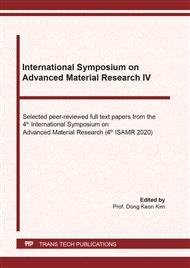[1]
Iman Dankar, Amira Haddarah, Fawaz E.L. Omar, Francesc Sepulcre, Montserrat Pujolà. 3D printing technology: The new era for food customization and elaboration. Trends in Food Science & Technology, Volume 75, May 2018, Pages 231-242.
DOI: 10.1016/j.tifs.2018.03.018
Google Scholar
[2]
Zhenbin Liu, Min Zhang, Bhesh Bhandari, Yuchuan Wang. 3D printing: Printing precision and application in food sector. Trends in Food Science & Technology, Volume 69, Part A, November 2017, Pages 83-94.
DOI: 10.1016/j.tifs.2017.08.018
Google Scholar
[3]
Jie Sun, Zhuo Peng, Weibiao Zhou, Jerry Y.H. Fuh, Geok Soon Hong, Annette Chiu. A Review on 3D Printing for Customized Food Fabrication. Procedia Manufacturing, Volume 1, 2015, Pages 308–319.
DOI: 10.1016/j.promfg.2015.09.057
Google Scholar
[4]
Diaz et al., 2014a J.V. Diaz, B.K.J.C. Van, M.W.J. Noort, J. Henket, P. Briër. Method for the Production of Edible Objects Using Sls and Food Products. Google Patents (2014).
Google Scholar
[5]
E.M. Sachs, J.S. Haggerty, M.J. Cima, P.A. Williams. Three-dimensional printing techniques. Google patents (1994).
Google Scholar
[6]
S.V. Murphy, A. Atala. 3D bioprinting of tissues and organs Nat. Biotech., 32 (8) (2014), pp.773-785.
DOI: 10.1038/nbt.2958
Google Scholar
[7]
Jie Sun, Weibiao Zhou, Liangkun Yan, Dejian Huang, Lien-ya Lin. Extrusion-based food printing for digitalized food design and nutrition control. Journal of Food Engineering, Volume 220, March 2018, Pages 1-11.
DOI: 10.1016/j.jfoodeng.2017.02.028
Google Scholar
[8]
Mary Kathryn Thompson, Giovanni Moroni, Tom Vaneker, Georges Fadeld, R. Ian Campbelle, Ian Gibsonf, Alain Bernard, Joachim Schulz, Patricia Graf, Bhrigu Ahuja, Filomeno Martinaj. Design for Additive Manufacturing: Trends, opportunities, considerations, and constraints. CIRP Annals Manufacturing Technology 65 (2016) 737–760738.
DOI: 10.1016/j.cirp.2016.05.004
Google Scholar
[9]
Matthew Lanaro, David P.Forrestal, Stefan Scheurer, Damien J.Slinger, Sam Liao, Sean K.Powell, Maria A.Woodruff. 3D printing complex chocolate objects: Platform design, optimization and evaluation. Journal of Food Engineering, Volume 215, December 2017, Pages 13-22.
DOI: 10.1016/j.jfoodeng.2017.06.029
Google Scholar
[10]
L. Hao, S. Mellor, O. Seaman, J. Henderson, N. Sewell, M. Sloan. Material characterisation and process development for chocolate additive layer manufacturing. Virtual Phys. Prototyp., 5 (2) (2010), pp.57-64.
DOI: 10.1080/17452751003753212
Google Scholar
[11]
Zhenbin Liu, Min Zhang, Bhesh Bhandari, Chaohui Yang. Impact of rheological properties of mashed potatoes on 3D printing. Journal of Food Engineering 220 (2018) 76-82.
DOI: 10.1016/j.jfoodeng.2017.04.017
Google Scholar
[12]
Wenbin Li, Amir Ghazanfari, Ming C. Leu & Robert G. Landers (2017): Extrusion-on-demand methods for high solids loading ceramic paste in freeform extrusion fabrication, Virtual and Physical Prototyping,.
DOI: 10.1080/17452759.2017.1312735
Google Scholar
[13]
J.I. Orisaleye, O.A. Adefuye, A.A Ogundare, O.L. Fadipe. Parametric analysis and design of a screw extruder for slightly non-Newtonian (pseudoplastic) materials. Engineering Science and Technology, an International Journal. 2018 (21). 229-237.
DOI: 10.1016/j.jestch.2018.03.001
Google Scholar
[14]
Jitiporn Cruanate. Newtonian Non-Fluid Mechanics, Part 1. Journal of materials technology, (2003), Issue 30 Pages 25-28.
Google Scholar


